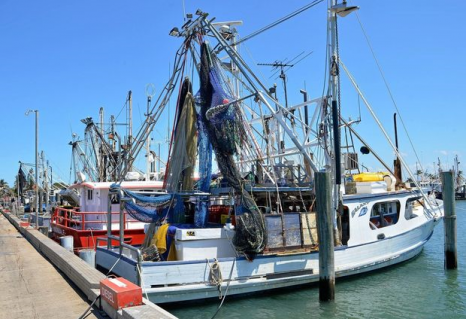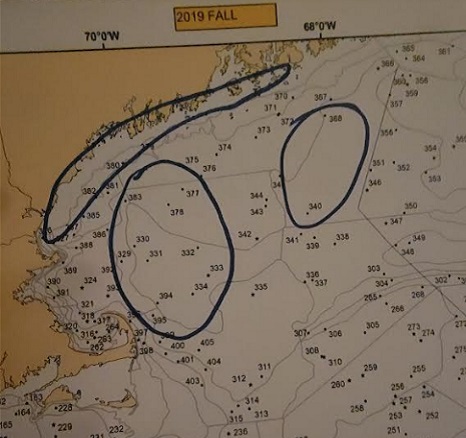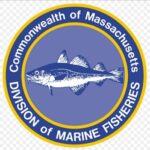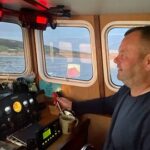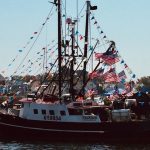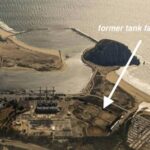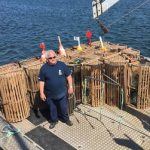Search Results for: white spot
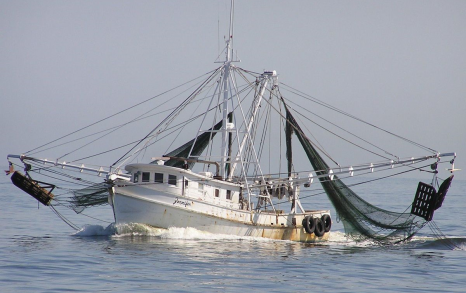
Louisiana Shrimp Fishermen Face New Challenges – White Spot Disease
The experience is not universal within the nation’s eight shrimp-producing states, nor even within Louisiana. That’s why some shrimpers suspect that undiagnosed trouble may lurk within the local fishery itself. At the tail end of this year’s crawfish season, white spot disease was detected in Louisiana ponds. It’s not too far a jump, some in the industry, to suspect contamination with the virus as a cause for decline. “Is it the same strain that is in the Asian shrimp that gets imported here?” said Acy Cooper, president of the Louisiana Shrimp Association.,,, Jeffrey Marx, the chief shrimp biologist at the Louisiana Department of Wildlife and Fisheries, is skeptical.,,, Fishermen want more research to be done, and some precautions to be taken, however. click here to read the story for links about White Spot here and Australia click here 08:34
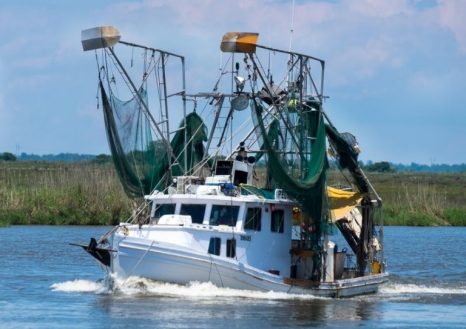
White spot – Shellfish disease unlikely to become major threat to shrimp
A shellfish killing disease discovered in crawfish ponds around Louisiana about a month ago isn’t as likely to be a major threat to the shrimp population, state officials say. Louisiana Department of Wildlife and Fisheries biologist Jeff Marx said the virus is most likely in wild populations, but it shouldn’t affect wild shrimp as much as the crawfish because shrimp aren’t in contained spaces like crawfish are. Although the disease has only been found in crawfish, it could also infect shrimp and crabs in coastal estuaries, according to a report by the LSU Ag Center. Shrimp and crab will be tested for the virus. click here to read the story 14:57
Unlikely to become a major threat? They thought that in Queensland. Australia: Fears grow as white spot detected in crab in Logan River, click here for more info.
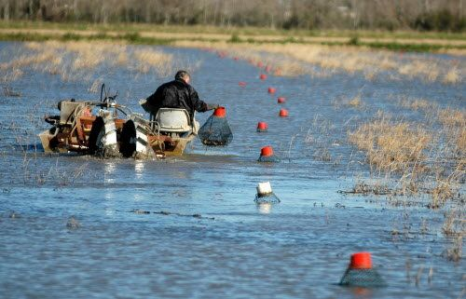
Deadly White Spot Syndrome in Louisiana crawfish farms could imperil $300 million industry
The crawfish industry in south Louisiana is growing concerned by a deadly virus that threatens the crop. White spot syndrome virus was first discovered in farmed shrimp in Thailand and China in the early 1990s, but it was not known in Louisiana crawfish until 2007, the LSU AgCenter says. “Symptoms include sluggish crawfish that don’t move much once they are dumped from the trap. They do not pinch hard and most cannot walk,” the AgCenter says. How did the virus get to Louisiana? Here’s what the AgCenter says: “No one can say with any certainty. There are many possibilities. Many countries export both pond-raised and wild shrimp to the United States. A study of imported shrimp indicates occurrence of WSSV may be very high in these products. Here’s the rub – “Imported frozen shrimp used as bait for coastal fishing is also a hazard. Leftover bait shrimp that is discarded could be picked up by wild shrimp or crabs, thereby creating immediate risks for those populations and spread to others. The same risk to wild crawfish exists when frozen imported shrimp are used for bait in inland waters. Click here to read the story 11:26
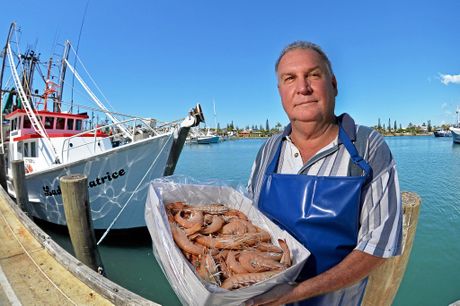
Fishing industry rattled as white spot disease breaks barriers
It was the outbreak they were expecting, but hoping would never come to pass. Concern and uncertainty seem to the prevailing moods amongst the Queensland commercial fishing industry, reeling from this week’s news that white spot disease had broken it’s containment in the Logan River and been detected in Moreton Bay. There’s also considerable frustration amongst members of the Queensland Seafood Industry Association (QSIA), many of whom predicted the outbreak was a matter of ‘when’, not ‘if’. “It definitely hasn’t been a good week for us,” says QSIA’s CEO Eric Perez. “There’s certainly a lot of concern about the impact this will have on the industry here, as well as the knock-on effects this will have on the wider community.” There appears to be no immediate threat to fisheries in the Gympie and Cooloola Cove regions, but tests are ongoing just to determine how far the disease has spread. continue reading the story here 11:16
Fears for prawn industry grow after white spot found in Moreton Bay
 The ban on movement of uncooked prawns and crustaceans outside a new control zone could lead to cheaper seafood for south-east Queenslanders. Uncooked products will not be allowed to leave the area, which includes Brisbane, the Gold Coast and Moreton Bay, but they can be sold within the area. The movement order, effective immediately, includes crabs, prawns, yabbies, Moreton Bay bugs and marine worms. It comes after positive test results on several properties in the Logan River. Agriculture Minister Bill Byrne briefed prawn farmers, commercial fishers and others in the industry on Thursday morning, but some trawlers are still at sea and will need to be spoken to when they return. The prawns were caught within the past week at the Redcliffe Peninsula and Deception Bay, with 31 testing positive. continue reading the story here 21:52
The ban on movement of uncooked prawns and crustaceans outside a new control zone could lead to cheaper seafood for south-east Queenslanders. Uncooked products will not be allowed to leave the area, which includes Brisbane, the Gold Coast and Moreton Bay, but they can be sold within the area. The movement order, effective immediately, includes crabs, prawns, yabbies, Moreton Bay bugs and marine worms. It comes after positive test results on several properties in the Logan River. Agriculture Minister Bill Byrne briefed prawn farmers, commercial fishers and others in the industry on Thursday morning, but some trawlers are still at sea and will need to be spoken to when they return. The prawns were caught within the past week at the Redcliffe Peninsula and Deception Bay, with 31 testing positive. continue reading the story here 21:52
White spot threat: is fishing finished in Queensland?
 The Logan River white spot epidemic could destroy all mainland fishing in Queensland, including a big slice of the Cooloola Coast seafood and tourism economy, industry leader Kev Reibel has warned. A Queensland Seafood Industry Association board member and Tin Can Bay trawler operator, Mr Reibel said the threat was credible and immediate. “To say we are worried would be something of an understatement,” he said in an exclusive interview with The Gympie Times on Sunday. “We don’t know if it can be stopped and we don’t know its boundaries within the crustaceans, or even if it has any boundaries. If it affects crabs, that’s another industry and another tourism factor wiped out. He backed claims by industry environmental adviser and Bay net fishing operator Joe McLeod that the apparently unstoppable virus is a threat to the food chains which sustain all kinds of fin fishing. Mr McLeod said the plankton that kicked off the fin fish food chain included juvenile prawns and other crustaceans. “If they’re not there, there is nothing for the fish to eat,” Mr McLeod said yesterday. Both said there was a fearful lack of knowledge of the virus’ boundaries, especially with the crustacean group. Continue reading the story here 09:32
The Logan River white spot epidemic could destroy all mainland fishing in Queensland, including a big slice of the Cooloola Coast seafood and tourism economy, industry leader Kev Reibel has warned. A Queensland Seafood Industry Association board member and Tin Can Bay trawler operator, Mr Reibel said the threat was credible and immediate. “To say we are worried would be something of an understatement,” he said in an exclusive interview with The Gympie Times on Sunday. “We don’t know if it can be stopped and we don’t know its boundaries within the crustaceans, or even if it has any boundaries. If it affects crabs, that’s another industry and another tourism factor wiped out. He backed claims by industry environmental adviser and Bay net fishing operator Joe McLeod that the apparently unstoppable virus is a threat to the food chains which sustain all kinds of fin fishing. Mr McLeod said the plankton that kicked off the fin fish food chain included juvenile prawns and other crustaceans. “If they’re not there, there is nothing for the fish to eat,” Mr McLeod said yesterday. Both said there was a fearful lack of knowledge of the virus’ boundaries, especially with the crustacean group. Continue reading the story here 09:32
White Spot Disease: Gold Coast prawn industry in ruins as 1500 tonnes of seafood left to rot
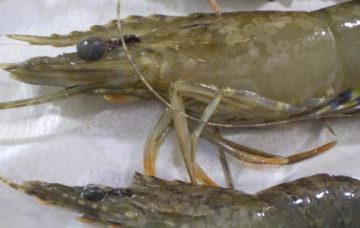 About 1500 tonnes of poisonous prawns are rotting in ponds in the northern Gold Coast and the State Government has no idea what to do about it. The tiger prawns have been decaying in 112 ponds in Alberton and Woongoolba over the past month after Biosecurity ordered they be killed to help get on top of the white spot disease crisis that has ravaged the industry. Angry farmers say their hands are tied as they risk polluting major waterways and cruelling other industries if they release the dead prawns, killed by 2.8 million litres of chlorine. In addition to the prawns, some farmers were also worried small live crabs may have escaped the ponds when they were disinfected last month and carried the disease into rivers. Read the story here 10:27
About 1500 tonnes of poisonous prawns are rotting in ponds in the northern Gold Coast and the State Government has no idea what to do about it. The tiger prawns have been decaying in 112 ponds in Alberton and Woongoolba over the past month after Biosecurity ordered they be killed to help get on top of the white spot disease crisis that has ravaged the industry. Angry farmers say their hands are tied as they risk polluting major waterways and cruelling other industries if they release the dead prawns, killed by 2.8 million litres of chlorine. In addition to the prawns, some farmers were also worried small live crabs may have escaped the ponds when they were disinfected last month and carried the disease into rivers. Read the story here 10:27
Indefinite ban on prawn imports after outbreak of white spot disease in Queensland
 Deputy Prime Minister Barnaby Joyce has this morning bowed to pressure from prawn farmers and indefinitely banned importation of the frozen crustacean, following an outbreak of the devastating white spot disease in Queensland. Farmers have been lobbying for the suspension of Asian prawn imports following the discovery of the disease in five separate locations of the Logan River, south of Brisbane, last month. Mr Joyce said he was concerned the prawns infected prawns could make it into the waterways, further spreading the disease in Australian prawn farms. The biosecurity minister urged people who have bought raw green prawns not to put them in water ways, like using them as bait for fishing, with fears it could contaminate local prawns. Mr Joyce said a white spot disease outbreak could devastate Australia’s $360 million prawn industry. Read the story here 09:44
Deputy Prime Minister Barnaby Joyce has this morning bowed to pressure from prawn farmers and indefinitely banned importation of the frozen crustacean, following an outbreak of the devastating white spot disease in Queensland. Farmers have been lobbying for the suspension of Asian prawn imports following the discovery of the disease in five separate locations of the Logan River, south of Brisbane, last month. Mr Joyce said he was concerned the prawns infected prawns could make it into the waterways, further spreading the disease in Australian prawn farms. The biosecurity minister urged people who have bought raw green prawns not to put them in water ways, like using them as bait for fishing, with fears it could contaminate local prawns. Mr Joyce said a white spot disease outbreak could devastate Australia’s $360 million prawn industry. Read the story here 09:44
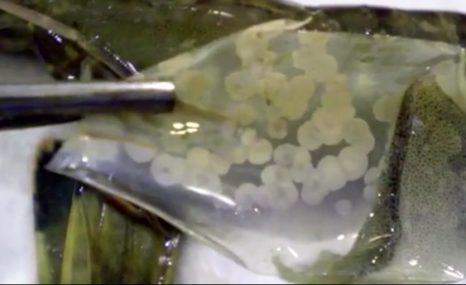
Australia: Fears grow as white spot detected in crab in Logan River
The devastating white spot disease threatening the Logan River prawn farming industry has now been detected in a crab. If retesting confirms the virus, it would be the first time the disease has transferred between species in Australia. Biosecurity Queensland tested the crab, which was found in a drainage channel near one of the infected prawn farms, this week and confirmed it initially tested positive for the virus that causes white spot. White spot, which can cause 100 per cent mortality within 10 days in farmed prawns, was first detected at a farm in Alberton, south of Brisbane, on November 22. The disease has spread to four other farms, forcing each farm to completely de-stock, a move estimated to cost the industry $25 million. Until the outbreak, Australia was considered free of white spot, which has spread throughout Asia and the Americas but does not pose a risk to humans. The detection in the crab was the first time the disease has appeared outside of a farm since six wild prawns were discovered with “low levels” of the disease on December 8. Read the story here 12:13
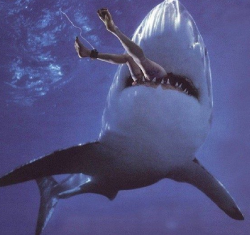
Mystery: One-time “Shark Capital of the World” Cape Town, South Africa has lost all of its “man-eating” Great Whites!
I’ve been so busy keeping up with the heaps and heaps of Great White sharks turning my once bucolic North County, San Diego paradise into a blood-curdling hell that I’ve not kept up with one-time “Shark Capital of the World” Cape Town, South Africa. The man-eating beasts were a constant threat for Afrikaans-speaking locals. Attacks were not uncommon and neither were deaths. Extremely scary but waters once teeming with ghastly teeth and rolled-back eyes are now peaceful. No Great White has been spotted in over eighteen months. >click to read< 14:57
Great white shark named after Big Papi
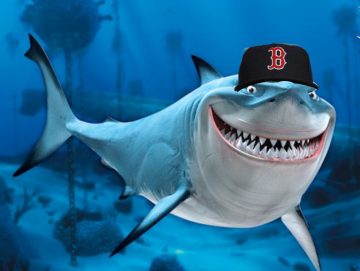 A great white shark spotted off the coast of Cape Cod has been named after retiring Boston Red Sox slugger David Ortiz. The Boston Globe reported that researchers from the nonprofit Atlantic White Shark Conservancy announced Saturday they were naming the 15-foot male shark “Big Papi” in honor of Ortiz, who is known by that nickname. The great white was tagged Sept. 9 off the coast of Wellfleet by state biologist Greg Skomal during an excursion with the conservancy. “Big Papi” is one of 19 sharks tagged off the Cape Cod coast since the start of the summer. 19:11
A great white shark spotted off the coast of Cape Cod has been named after retiring Boston Red Sox slugger David Ortiz. The Boston Globe reported that researchers from the nonprofit Atlantic White Shark Conservancy announced Saturday they were naming the 15-foot male shark “Big Papi” in honor of Ortiz, who is known by that nickname. The great white was tagged Sept. 9 off the coast of Wellfleet by state biologist Greg Skomal during an excursion with the conservancy. “Big Papi” is one of 19 sharks tagged off the Cape Cod coast since the start of the summer. 19:11
Great white shark numbers off Massachusetts rose sharply last year
 A big jump in the number of great white sharks seen off Massachusetts has given rise to a couple of compelling mysteries. Greg Skomal, senior marine fisheries scientist for the state government, tags great whites along the coast. He collaborates with researchers in Halifax who tag blue sharks and other species, and collect data from Skomal’s tags when they’re in Canadian waters. Skomal is still collecting this year’s data, so he can’t comment on it yet. But from mid-June to October in 2014, his team identified 68 individual white sharks off the eastern shore of Cape Cod. In the summer of 2015, that number increased to 141 individuals. There are still many questions left to answer, such as what proportion of the total existing population is being spotted off the coastline. “Is it 10 per cent, is it five per cent, is it 50 per cent?” he said. “We could be seeing just a fraction of what’s out here.” Read the rest here 09:13
A big jump in the number of great white sharks seen off Massachusetts has given rise to a couple of compelling mysteries. Greg Skomal, senior marine fisheries scientist for the state government, tags great whites along the coast. He collaborates with researchers in Halifax who tag blue sharks and other species, and collect data from Skomal’s tags when they’re in Canadian waters. Skomal is still collecting this year’s data, so he can’t comment on it yet. But from mid-June to October in 2014, his team identified 68 individual white sharks off the eastern shore of Cape Cod. In the summer of 2015, that number increased to 141 individuals. There are still many questions left to answer, such as what proportion of the total existing population is being spotted off the coastline. “Is it 10 per cent, is it five per cent, is it 50 per cent?” he said. “We could be seeing just a fraction of what’s out here.” Read the rest here 09:13
Ten things you need to know about British Columbia spot prawns
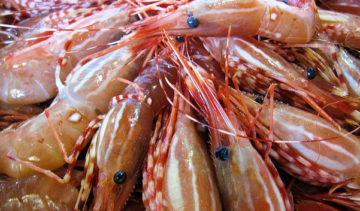 A decade ago, British Columbia spot prawns were a bottom-of-the-barrel seafood product – the mushy filler for chowder and fortifier of cheap fish stock. Last weekend, the luxury crustaceans were toasted with Moët & Chandon champagne. To celebrate its 10th anniversary, the B.C. Spot Prawn Festival kicked off Friday night with a black-tie gala at the tony, private Vancouver Club. The wild B.C. spot prawn is the largest of all seven commercial species of shrimp found in the Pacific Northwest. Some grow bigger than a human hand – up to about 23 centimetres in length. They are reddish-brown, turning bright pink when cooked, with defining white spots on their tails. When properly handled and cooked, they are firm in texture, with a luscious, sweet flavor. Read the rest here 10:07
A decade ago, British Columbia spot prawns were a bottom-of-the-barrel seafood product – the mushy filler for chowder and fortifier of cheap fish stock. Last weekend, the luxury crustaceans were toasted with Moët & Chandon champagne. To celebrate its 10th anniversary, the B.C. Spot Prawn Festival kicked off Friday night with a black-tie gala at the tony, private Vancouver Club. The wild B.C. spot prawn is the largest of all seven commercial species of shrimp found in the Pacific Northwest. Some grow bigger than a human hand – up to about 23 centimetres in length. They are reddish-brown, turning bright pink when cooked, with defining white spots on their tails. When properly handled and cooked, they are firm in texture, with a luscious, sweet flavor. Read the rest here 10:07
Cape Cod seals return in masses on video: Great whites and fishermen woes follow
 Before 1972 you were lucky to see a single seal in the waters or on the beaches of the Cape. Then when the Marine Mammal Protection Act went into effect, the hunting abruptly stopped and they were able to grow in number and that brings it up to the masses of seals being spotted today! They inhabited the beaches in masses until they were almost hunted to extinction along the Cape’s waters decades ago. Now that they are a protected species, their numbers are up, too far up for some folks who live and work on the Cape and surrounding areas. The fishermen who utilize these waters for their livelihood say that the seals are eating all the fish. The seals do eat a lot of fish. An 800-pound male seal “could consume up to six percent of his body weight each day. That’s 50 pounds of fish, including valuable species like cod and flounder.” With the seal population numbering in the thousands, you don’t have to do the math to see these summer residents are competition for the fishermen. Video, read the story here 10:56
Before 1972 you were lucky to see a single seal in the waters or on the beaches of the Cape. Then when the Marine Mammal Protection Act went into effect, the hunting abruptly stopped and they were able to grow in number and that brings it up to the masses of seals being spotted today! They inhabited the beaches in masses until they were almost hunted to extinction along the Cape’s waters decades ago. Now that they are a protected species, their numbers are up, too far up for some folks who live and work on the Cape and surrounding areas. The fishermen who utilize these waters for their livelihood say that the seals are eating all the fish. The seals do eat a lot of fish. An 800-pound male seal “could consume up to six percent of his body weight each day. That’s 50 pounds of fish, including valuable species like cod and flounder.” With the seal population numbering in the thousands, you don’t have to do the math to see these summer residents are competition for the fishermen. Video, read the story here 10:56
Bering Sea Crabbers Release White Paper Tackling the Economic Impact of Illegal Crab Poaching in Russia on the U.S.
 Frequentz and the Alaska Bering Sea Crabbers’ is pleased to announce the release of a white paper shedding light on the estimated $600 million lost in U.S. tax revenue and commercial fishing profits since 2000 as a result of competition with illegal Russian crab. In addition to the significant economic impact and threat to the livelihoods of small, independently owned family businesses, the paper explains how consumers are being duped by illegally harvested crab entering the global supply chain, often under the guise of being sustainably sourced. Read the rest here 08:35
Frequentz and the Alaska Bering Sea Crabbers’ is pleased to announce the release of a white paper shedding light on the estimated $600 million lost in U.S. tax revenue and commercial fishing profits since 2000 as a result of competition with illegal Russian crab. In addition to the significant economic impact and threat to the livelihoods of small, independently owned family businesses, the paper explains how consumers are being duped by illegally harvested crab entering the global supply chain, often under the guise of being sustainably sourced. Read the rest here 08:35
Welcome to Ocean County, Mary Lee. 3,500-lbs. great white shark off Long Beach Island
 Welcome to Ocean County, Mary Lee. The nearly 16-foot, 3,456-pound female great white shark (or Carcharodon carcharias, if you prefer the scientific term), which goes by the name Mary Lee, was last spotted off the southern end of Long Beach Island this morning after reaching the coast of New Jersey yesterday. The great white shark appears to trekking its way north along the New Jersey coastline, just a couple weeks away from Memorial Day Weekend and the kickoff to beach season. Read the rest here 12:30
Welcome to Ocean County, Mary Lee. The nearly 16-foot, 3,456-pound female great white shark (or Carcharodon carcharias, if you prefer the scientific term), which goes by the name Mary Lee, was last spotted off the southern end of Long Beach Island this morning after reaching the coast of New Jersey yesterday. The great white shark appears to trekking its way north along the New Jersey coastline, just a couple weeks away from Memorial Day Weekend and the kickoff to beach season. Read the rest here 12:30
Eastern U.S. and Canada: Great white shark population surging, study says
 A report that scientists are calling one of the most comprehensive studies of great white sharks finds their numbers are surging in the ocean off the Eastern U.S. and Canada after decades of decline — bad news if you’re a seal, but something experts say shouldn’t instill fear in beachgoers this summer. Read more here 13:38
A report that scientists are calling one of the most comprehensive studies of great white sharks finds their numbers are surging in the ocean off the Eastern U.S. and Canada after decades of decline — bad news if you’re a seal, but something experts say shouldn’t instill fear in beachgoers this summer. Read more here 13:38
Lydia The Flying Great White Shark Puts Cornwall On Summer Alert
 THE DAILY Star has chilling news: Lydia is coming to the UK. Lock up your flippers and stick a plug in the sink. The tabloids works in cycles. The first signs of the impending summer are, in order: a) Great White Shark Spotted off Coast b) Madeleine McCann spotted on land c) Lucy from Brighton spotted on beach d) Killer heatwave spotted in space. News is that Lydia was tagged by scientists. And she’s been recorded swimming in the mid Atlantic. Or as the Indy has it, flying: Read more here 08:18
THE DAILY Star has chilling news: Lydia is coming to the UK. Lock up your flippers and stick a plug in the sink. The tabloids works in cycles. The first signs of the impending summer are, in order: a) Great White Shark Spotted off Coast b) Madeleine McCann spotted on land c) Lucy from Brighton spotted on beach d) Killer heatwave spotted in space. News is that Lydia was tagged by scientists. And she’s been recorded swimming in the mid Atlantic. Or as the Indy has it, flying: Read more here 08:18
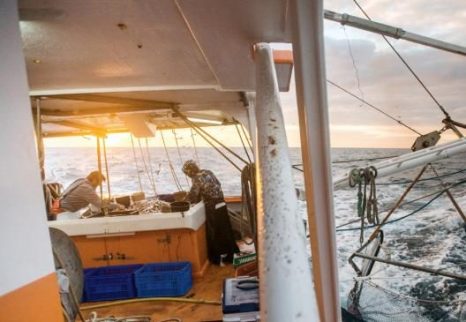
Gold Coast prawn prices ‘highest in 35 years’ ahead of Christmas according to seafood shops
Seafood lovers have been told to brace for an expensive festive season with Gold Coast prawn prices already at a 35-year high at some retailers. The price of large king prawns, at $40 a kilogram, are already at Christmas peak levels.“I’ve never seen prices this high at this time of year,” said Tasman Star Seafoods co-owner Peter Duncombe. The price hike has been blamed on major reforms in the NSW commercial fishing industry have resulted in fewer prawn boats out on the water, a “fizzer” start to the season for trawlers, and a fallout from the devastating white spot disease which shut down Gold Coast prawn farms this year. click here to read the story 15:45
Killer virus that devastated Gold Coast prawn farmers is on the doorstep of Moreton Bay’s multimillion-dollar fishing industry.
 More than 100 wild prawns just south of the Logan River in Southern Moreton Bay have tested positive to the virus responsible for the deadly white spot disease. The virus can kill whole ponds of prawns within days and experts fear it could easily spread to other crustaceans such as mud crabs and Moreton Bay bugs. Announcing the positive testing of 108 wild prawns yesterday, Biosecurity Queensland confirmed the outbreak that ravaged prawn farmers for the past two months had been found outside the Logan River for the first time. Griffith University ecologist Professor Michelle Burford said the disease could move into the main part of Moreton Bay, threatening a large chunk of Queensland’s $120 million wild-caught fishing industry. “There is every potential for the disease to move into other areas,” Prof Burford said. Read the story here 09:41
More than 100 wild prawns just south of the Logan River in Southern Moreton Bay have tested positive to the virus responsible for the deadly white spot disease. The virus can kill whole ponds of prawns within days and experts fear it could easily spread to other crustaceans such as mud crabs and Moreton Bay bugs. Announcing the positive testing of 108 wild prawns yesterday, Biosecurity Queensland confirmed the outbreak that ravaged prawn farmers for the past two months had been found outside the Logan River for the first time. Griffith University ecologist Professor Michelle Burford said the disease could move into the main part of Moreton Bay, threatening a large chunk of Queensland’s $120 million wild-caught fishing industry. “There is every potential for the disease to move into other areas,” Prof Burford said. Read the story here 09:41
Queensland Prawn importers under investigation for biosecurity breach
 A number of prawn suppliers and importers are under investigation for not meeting biosecurity measures in the time leading up to a disease outbreak. The Department of Agriculture and Water Services had been investigating the suppliers and importers since August 2016, five months before it became public that white spot disease had been detected in Queensland. Since December five prawn farms had tested positive for the virus, which causes a high death rate in the crustacean, and the import of green prawns had been banned indefinitely. The maximum penalty if the suppliers and importers are found to have been illegally importing goods for a commercial advantage under the Biosecurity Act 2015 is 10 years in prison or $360,000 or both. Read the story here 10:06
A number of prawn suppliers and importers are under investigation for not meeting biosecurity measures in the time leading up to a disease outbreak. The Department of Agriculture and Water Services had been investigating the suppliers and importers since August 2016, five months before it became public that white spot disease had been detected in Queensland. Since December five prawn farms had tested positive for the virus, which causes a high death rate in the crustacean, and the import of green prawns had been banned indefinitely. The maximum penalty if the suppliers and importers are found to have been illegally importing goods for a commercial advantage under the Biosecurity Act 2015 is 10 years in prison or $360,000 or both. Read the story here 10:06
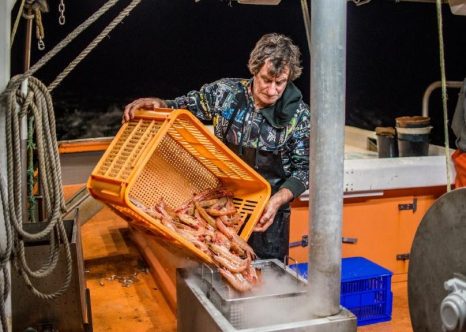
Importing seafood to Australia is like the governor of Alaska deciding to import ice – With Julian Tomlinson
Importing seafood to Australia must rank among the most jaw-droppingly gormless decisions ever made by someone claiming to have a fully functioning brain. It’s like the governor of Alaska deciding to import ice – but from a producer who uses water from a stagnant lake that is rapidly drying out. The south-east Queensland prawn farming industry is on the brink of disaster after white spot disease infected stock right before the lucrative Christmas period. Far Northern prawn farmers are rubbing their hands together and worrying at the same time. Loss of supply from the south-east should drive up demand for their product, but there are fears the disease was brought in from overseas imports and is spreading via birds. Australia has the world’s largest exclusive fishable area, waters of excellent quality, and among the most sustainable and high-quality seafood in the world. But the Aussie fishing industry has the lowest wild-harvest rate in the developed world and has been demonised and regulated so much that our supplies can’t meet domestic demand. Read the op-ed here If you’ve got time, a report also available (click here to read Australia’s Unappreciated and Maligned Fisheries. 09:40
Disease outbreak in Logan River prawns turns ugly as politicians go to war on compensation
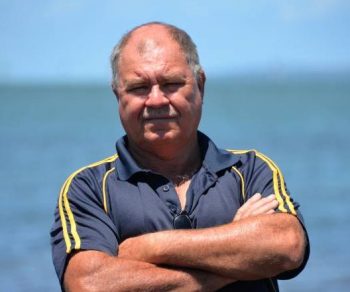 PROFESSIONAL fishermen have called for a total Logan River fishing ban in an attempt to control the spread of an exotic disease in prawns. It comes as a brawl breaks out between politicians over compensation for prawn farmers and trawler operators whose businesses have closed due to white spot disease. The disease has been found in a Logan River prawn farm, prompting the closure of it and two of the eight others nearby in the $88 million a year industry. A ban on fishing for crustaceans is already in place. Fisheries Minister Bill Byrne said no compensation would be paid but Logan River farmers and fishermen would have costs reimbursed for any work carried out under the direction of Biosecurity Queensland. Read the story here 19:46
PROFESSIONAL fishermen have called for a total Logan River fishing ban in an attempt to control the spread of an exotic disease in prawns. It comes as a brawl breaks out between politicians over compensation for prawn farmers and trawler operators whose businesses have closed due to white spot disease. The disease has been found in a Logan River prawn farm, prompting the closure of it and two of the eight others nearby in the $88 million a year industry. A ban on fishing for crustaceans is already in place. Fisheries Minister Bill Byrne said no compensation would be paid but Logan River farmers and fishermen would have costs reimbursed for any work carried out under the direction of Biosecurity Queensland. Read the story here 19:46
“Looking Back; “Fishery management; best available science, or politics?” 2009. By Jim Lovgren
Much has been made of the Bush administration’s disdain for science, especially in cases where environmental concerns could have an effect on a wealthy campaign contributing corporation’s bottom line. From the butchering of the EPA’s report on global warming, to the interior department’s political interference on endangered species rulings, the Bush administration has shown an almost total disdain for the environment and the creatures that inhabit it, with one glaring exception, the Ocean. The administration has bent over backwards to curry favor to a well-financed group of
ocean advocates, primarily funded by the PEW Charitable Trusts. The National Marine Fishery Service [NMFS], has conducted its own campaign of politically motivated advocacy science, except in this rare instance the administration has seemingly been trying to protect the environment.
So, lets look a little closer at what’s been going on behind closed doors. First thing to realize is that for the last 8 years “Big Oil” has occupied our White house, and that they will do anything to advance their “obscene profits” agenda. No science is safe, since through the machinations of multi-national corporations, and their controls of virtually all forms of media, Global warming can be dismissed as a slight annoyance. Politically, wars can be justified by false accusations of weapons of mass destruction and not the oil reserves that were the real prize. In the case of U.S. fisheries, it appears that the Administration has attempted to atone for their gross contempt of terrestrial ecosystem concerns by placating the environmental industry by saving the oceans. In reality they are just reducing the monetary liabilities of the oil companies by putting the fishing industry out of business.
If you were the leaders of a multi national oil company that wanted to drill on the US East coast, how would you do it? Obviously you would have to remove the impediment’s to drilling, the Fishermen, and the environmentalists. First, you need to establish a seemingly unbiased funding mechanism to promote your goals. That’s where the PEW charitable trusts come in, a multi billion dollar non profit, with a seemingly spotless reputation, that was established by Joseph Pew. Coincidentally, Joseph Pew was the founder of Sun oil company, and that is where all the foundation money came from.
PEW claims that they have no connection to big oil anymore, they are just a public policy advocacy group. They don’t mention that half the Board of Directors are Pew family members, and you can bet their investment portfolio is heavily invested in oil stocks. To say that the PEW foundation has no relation to big oil is like saying the Swift boat veterans group were not funded by republicans. Using an octopus array of splinter groups to disguise the true source of the funding, Big oil has funded Swift boat attacks by a myriad of ethically challenged “environmental groups”, [ who were only to glad to grab the money], to target overfishing, using PEW funded advocacy scientists who will say anything for a dollar. They also pay a very efficient publicity firm to spread the “news” to the media. Next, to add some real punch to the plan create an Ocean advocacy group and engage a diverse group of mostly uninformed “experts”, and write an all encompassing paper describing the global threats to the ocean ecosystem, but conveniently relegate the disastrous effects of oil drilling and spills, to a tiny afterthought, despite thousands of pages of otherwise excellent material. But if you really want to put fishermen out of business, use the government to do it.
The National Marine Fisheries Service is located in the outhouse on the hill behind the Commerce Department building. They will march to whatever orders come from headquarters. Since the Bush Commerce Department was dominated by Multi national industry concerns, political agenda’s have driven science. In this case, that agenda was to allow oil drilling on the U.S. continental shelf, in area’s that have been off limits to drilling for over 25 years. In the waning days of the administration they have gotten their wish, the drilling ban has been lifted. Soon the oil companies will be free to
despoil the marine habitat of the U.S. east coast so that they can recover the estimated 600 million barrels of oil beneath it. Did I mention that this year those same oil companies exported over 600 millions barrels of U.S. produced oil to foreign nations? Seems to me that we wouldn’t have to drill here if we kept our oil reserves in our own country. Besides the potential damage to the fishing industry, and the ecosystem that oil spills and drilling mud’s would cause, the East coast tourism industry would be devastated. Despite one of the largest coastlines in the continental U.S. nobody goes to
Texas to enjoy the beaches, who wants to walk on tarballs? Is this what east coast states want?
Here’s where connections in the Commerce department come in handy. Have your PEW funded minions lobby congress to change the National Marine Fishery Service from an agency that worked to promote a healthy and sustainable fishing industry, into an agency that wants to turn the ocean into a petting zoo. Get the Science centers to create biological targets that are higher then anything ever observed for each species, and then demand that those targets be reached by each species at the same time, a biological impossibility. The scientists know this is an impossibility, yet they claim it can be theoretically accomplished. If you spent eight years in college to get a masters or doctorate degree in fishery population dynamics, you would say anything the government told you to say, because they are your only chance at employment in that field.
It has been clear to any commercial or recreational fisherman on the East coast for years that the government, wants to totally control every movement he makes.[VMS, and AIS tracking devises, overzealous enforcement agents, fishing licenses, etc.]. Part of this can be attributed to the job justification of government workers, the more government workers there are, the more they have to justify their jobs by controlling real workers who
actually produce a product that benefits society. History has shown that there is a value to regulation, [ie, “The tragedy of the commons”]. But regulation can go too far, and become far worse a menace then no regulation at all. Especially when that regulation is based on politically influenced science.
As both a fisherman, and a fishery manager, I heard for years fishermen complaining about what they believed to be unjust regulations, because the science was created by people who had no clue about how many fish were in the ocean, they just biannually made their random survey tows, at the wrong time of the year, with obsolete fishing nets, and out of whack towing cables, and then let their mathematicians prove whatever the Department of Commerce wanted proved.
So how bad has the science coming out of Woods Hole, [Northeast Fishery Science Center] been in the last eight years? I’d personally love to subpoena a few scientists and see what they think under oath, because some of the science is so bad that the scientist’s are either incompetent or they have no integrity. It is so bad in the North East that the fishing industry has had to hire their own scientists to develop alternate science to dispute the government’s findings. In each of the three fisheries in question, Scallops, Monkfish, and Summer Flounder, the government’s science was found to be sadly deficient. These three fisheries are among the five most valuable Fisheries on the East Coast, and the mismanagement of them has cost the economy hundreds of millions of dollars already. NMFS has a huge annual budget, you would think for the money they spend that they could create accurate science to manage a multi billion dollar fishing industry in a sustainable way. Sadly with less then a million dollars of capitol, the
commercial and recreational fishing industry has proven how poorly the science was for three critical species. Woods Hole has gone from being the most respected marine science center in the world, to being a joke, a bad one at that.
So lets look a little closer into just what exactly, the NMFS and its partner in crime the NEFSC has been up to in regard to helping their parent agency and its wealthy benefactors in their quest for oil. Ecosystem management has received much attention in the last decade as efforts to rebuild fish stocks have taken on increased public awareness. The carrying capacity of an ecosystem is the total amount of animals that can be biologically sustained within that ecosystem. There are natural highs and lows of different marine populations, usually caused by environmental conditions, and there are also manmade highs and lows such as the well-documented Groundfish / elasmobranches regime change on the Georges Bank. One thing is certain about ecosystem carrying capacity, there is an upper limit to how much biomass can be sustained, and this is predicated on how much food is available. The composition of the species can and will change, but they cannot exceed the carrying capacity without causing a collapse.
Our management system is based on biological targets that are set for each species that our councils manage. These targets are formulated by the fishery science centers using various complex mathematical equations to come to an educated guess of how many fish of each species should be in the ocean. The problem is that it is physically impossible for any ecosystem to sustain the rebuilt populations of every fish species at the same time, unless of course, the rebuilding targets are realistic and account for the natural fluctuations of nature. In the case of the Northeast region’s fisheries, the biological targets of many of the managed species are based upon the three-year moving average of the highest observed populations of these species based on the annual trawl surveys. Ask any scientist at the NEFSC if they think it is possible to have all of our fish stocks recovered to the present Biological targets at the same time, and they will tell you; it is impossible. Yet this is what we are trying to do. There are presently over a billion
pounds of spiny dogfish swimming around off the US east coast, three times more then were present in an unfished population in the 1960’s, yet we are forced to “rebuild” the population to a level that is unsustainable unless other stocks are not allowed to rebuild. By law that is impossible, the stocks must be rebuilt within a certain time frame or fisheries must be shut down. This whole system ignores the basic tenet of ecosystem carrying capacity. There simply would not be enough food to feed all of the fish that the NMFS insists should be in the ocean according to their unattainable biological targets. If it’s a consensus opinion of the scientists about the inability to have an ocean full of every species at the same time, then we are not dealing with management by science, but with management by policy.
NMFS insists on ignoring best available science when it comes to biological targets in relationship to ecosystem carrying capacity, yet they are required by law to use it. That is National Standard #2. The fact that they insist on attempting to reach all of these targets at the same time without acknowledging their impossibility or attempting to figure out rational targets in relationship to ecosystem management, and the corresponding carrying capacity of the ecosystem shows a complete disdain of the fishing industry that must suffer the economic consequences of this policy. This is also ignoring a National Standard, and that is National Standard # 8 ‘Conservation and management measures shall, consistent with the conservation requirements of this act [including the prevention of overfishing and rebuilding of overfished stocks], take into account the importance of fishery resources to fishing communities in order to {A] provide for the sustained participation of such communities, and {B] to the extent practicable, minimize adverse economic impacts on such communities.
So lets look at NMFS poster child for criminal mismanagement, Spiny Dogfish. Using the NMFS own science, we know that the total biomass of dogfish on the US east coast was around 150,000 MT in the 1960’s, and this was as close to a virgin population as you can come by. By the early 1990’s the population had increased to over 500,000 MT [over 1.2 billion pounds], as Dogfish and skates replaced the overfished Groundfish
stocks on the Georges Bank. The displacement of the valuable groundfish species was documented by the NEFSC own Steve Murowski and he stated in his paper, “Multi species size composition: A conservative property of exploited fishery systems?” “Given the current high abundance of skates and dogfish, it may not be possible to increase gadoid and flounder abundance without “extracting’ some of the current standing stock”. This paper was written in 1992 and a highly effective dogfish and skate fishery developed. [I might add that the little skate population also tripled from 1978 to 1990,
and the biological target was set at the highest level for this species also, although they prey on the same food stuff as many groundfish species]. The fishery that developed targeted primarily large females, those dogfish over 80 cm. long, as they were most desired by the market. During the 1990’s the spawning stock biomass,[SSB, mature females] of Dogfish dropped from 200,000 MT to 50,000 MT causing a chorus of howls about the imminent extinction of Spiny Dogfish. This although the total biomass remained above 400,00 MT, twice that of the 1960’s, while the SSB was actually at the
unfished level of the 1960’s. At the council level when creating a biological target was discussed, [there still is none], NEFSC brazenly omitted the population levels from the 1960’s and told the councils that the population was always at the 1980’s level. The council was also told that dogfish eat primarily jellyfish. When I pressed that issue they admitted that they ate a few fish. Almost every study known to man shows the dogfish to be a voracious predator of bony fishes. [ up to 80% of their diet]. Even as recently as this summer, at the spiny dogfish forum a NEFSC scientist told the audience that the dogfish population was always at the high level it is now at. This is not only providing misleading information, it is outright lying. Also at that forum Dave Pierce’s presentation brought to light not only how extensive dogfish predation was on other fish species, but also by
implication how NMFS has hid the information from the management councils. In a paper by J.S. Link, L.P. Garrison, and F.P. Almeida, called “Ecological interactions between elasmobranches and groundfish species on the northeastern U.S continental shelf: Evaluating predation” published in the North American Journal of fisheries management in 2002, it was disclosed that dogfish predation was almost 20 million summer flounder [ages 0 to 1] for the year 1998. That is close to half of the average annual recruitment of that species. Never once was that figure disclosed to the Mid
Atlantic Fishery Management council, despite the controversy surrounding the potential shutdown of that important species because of the stock not being able to reach its 2 times larger then ever observed Biological target. Yet every year, NMFS was at the management table claiming that retrospective analysis showed a large unaccounted for summer flounder mortality that must be blamed on commercial fishermen’s illegal landings or discards.
Over and over again managers heard how Dogfish were the most studied shark in the ocean, and that due to the depletion of the SSB dogfish would not recover for more then a generation. The most optimistic projections, using zero fishing mortality showed the earliest the stock would recover would be 2018. Most projections put the year to be at least 2030, one even showed never. Yet here we are in 2008 and the stock has miraculously been rebuilt in 7 years despite a continued fishery, and discard mortality of 20 million pounds a year. Conveniently ignored was the well studied case of the North west pacific Dogfish which was intensively fished to depletion in the late 1940’s, yet was healthier then ever by 1960. Scientists there discovered that the population would double every 8 years. Around 2003 the NEFSC put a new twist into the dogfish dilemma, There was no recruitment of pups, and they are smaller then normal,, OH MY GOD THE SKY IS FALLING! Totally ignoring density dependence science, [maybe the stock knows there are already to many of them, so they slow their reproduction so they don’t compete against themselves], Armageddon projections showed the stocks collapse and close to extinction within our lifetime. Although fishermen, argued that the trawl survey was missing these fish since they spend most of their early years in waters deeper then 100 fathoms, and the annual surveys only made a handful of tows in that water, this unfounded science became part of the rebuilding plan. I could spend hours pointing out different cases of bad science causing bad management, but Dogfish is the best example, it’s so blatant. How many examples’ can you think of? How can scientists be so wrong? As I said earlier, it’s either incompetence or no integrity.
I believe that criminal actions have been taken by the NMFS to destroy the commercial and recreational fishing industries on the East Coast. When science is doctored to fit a political agenda, wreaking economic devastation to the industries that depend on that science, that is Criminal. These people that have orchestrated this fiasco should be prosecuted. If you feel this way, then send or deliver this article to your congressman and senator, and tell him you demand justice. With a new administration coming in, it is important to know if they really want the truth about fisheries, or if they
will continue the Bush/ big oil agenda. Early returns with the appointment of a recipient of large amounts of PEW oil tainted dollars to the head of NOAA are not looking so good.
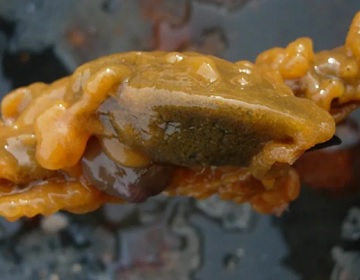
Sea vomit: Why DFO is worried about an invasive species with a disgusting name
Fisheries and Oceans Canada is asking fishermen to keep an eye out for an invasive species in the Bay of Fundy, one that has an unforgettable nickname. Pancake batter tunicate, more commonly known by its colloquial name sea vomit, has been spotted on the east coast of North America since 1982. The species is a creamy white colour, is slimy to the touch and is native to the ocean around Japan. It’s only been confirmed north of the U.S. border since 2013, but there is some evidence the invasive species is growing more prevalent in New Brunswick waters. >click to read< 09:06
350 years of experience
15 captains showed up today in Gloucester, Mass., and their total experience together was over 350 years of knowledge. We discussed the white hake issue. They say the biomass isn’t the problem they’re just not seeing small hake.
Well, fishermen don’t see small white hake very often due to us using 6.5″ diamond cod ends. The fish are small and slimy they slide right out the meshes. Hell, a medium pollock can swim out the mesh’s and they are twice to three times the size of small hake. Besides the point is a regulatory community that has never asked anyone in the room anything about fishing, have never asked what we were seeing, nor our thoughts about any species.
All fishermen unanimously agreed we were all going out of our way trying not to catch hake, changing our fishing patterns to work around known hot spots to duck and dodge hake. But we still seem to be catching an abundance of hake still, but the concern is there’s no smalls. Well, where did all these extra hake that are in these areas that don’t usually have hake doing there?
Meanwhile I look at the assessment tows seem to tackle the coastline but not much effort above Cape Ann, in Massachusetts. Seems they don’t check the coast of Maine. Maybe small juvenile fish stay along the coast till they branch out to deeper water. Makes sense bigger predator fish live outside that’s why we see larger hake in deeper water. But the fact is we all agreed on hot spots the surveys were avoiding as shown. We all unanimously agreed we’d take the time to work with the scientists and assist with the help of our 350 years of experience to work together.
Falling on deaf ears. I’ve called many people in the last week no real answers back and I’ll push it to the higher ups and no response. Even if they come out and say there’s no problem with the hake their still not going to change anything. But even though there’s nothing wrong with the biomass they want to cut the allowable catch again next year on a guess! Thats right folks a damn guess. The same information they are receiving from the research vessel with no real fishermen or use of their insight or input on the trawl tows which are 20 minute tows.
What would 350 years of experience teach researchers about fishing?
Hell, it takes 20 minutes for your gear to get on bottom and the doors to spread right to open the mouth of the net, then comes the speed in which you tow you’re gear. All these things matter to the size of you’re frame ,cable lengths, depth to wire ratio and speed. If any one of these things are wrong allow me to tell you, you’ll catch nothing to very, very little.
So, a computer prints tows out that tells the research vessel where to tow. But tide, slack water the difference in daylight to night tow they don’t check, its one and done and on to the next. Don’t even get me started with moon cycles and fish habits. Why are there no real survey trails in the deep water? Neither were in the 2019 survey nor the spring 2022 and the same areas off Maine and down east known hake bottom to fishermen have very little efforts. Like I said 350 years of knowledge all agreed where to look, but very different spots then some computer program.
Observer data? Well, that isn’t even looked at in the management level to assess the allocation of the specie. So, observers are there primarily in the northeast to watch what we do, but not use the information they gather to check against the survey tows. Total nonsense. 350 years of experience telling you the only problem they are seeing is the government not working with the industry.
We asked if we the fishermen could make an assessment of our own, again that’s a no no. Makes no sense at all.
Well, I guess a college degree means it outranks 350 years of experience. This means we’ll struggle on till we can’t. When the groundfish boats stop the bait line stops for the lobstermen. Besides they say there’s no small juvenile fish in abundance and they want to allow a wind farms power cables along the bottom which could wipe out these young rebuilding fish stocks. Makes no sense I tell you. Gulf of Maine haddock reduction by 80% next year, say there’s no small hake.
But they will run power lines under the main vein of the heart of the Gulf of Maine which could wipe out an entire ecosystem. How in the blue blazes of hell is that green?!!
I haven’t even gotten started with the economic problems this will start. Could you imagine every boat and fish wharf and shop up the coast of New England empty, broke and no income for anyone to make a payment on any of this infastructure or families and homes . Don’t think the banks could float that much money. Then a real possibility of an ecological disaster like we’ve never known while being in the poor house.
We the fishermen are willing to work with the science to get the best data. Hell the western US fleet does assessments with the fishermen but won’t let the New England fishermen. Makes no damn sense at all. We’ll just have to keep the faith. I’m calling on the fishermen and friends to get on board and spread the word we are united in this mismanagement fight. It’s not the scientist’s fault if the biased management team is misdirecting them based on a model that doesn’t work. We can fix this but it’s going to take everyone this is our nations heritage, and many have forgotten that. FISH ON MY FAMILY AND FRIENDS. Jerry Leeman

How an Unlucky Texas Fisherman Stumbled Upon an Environmental Catastrophe
Five years before a pair of bullets tore through his gut and heart, Billy Joe Aplin reached over the silt-smeared water of the tidal flats with a boat hook to snare a small buoy bobbing near the grassy shoreline. As he pulled it toward his skiff, the rope gathered in soggy coils by his white rubber boots. Billy Joe was a bear of a man, six feet with broad shoulders, strong nose, square jaw, and jet-black hair. Their skiff drifted calmly at the mouth of the Guadalupe River in San Antonio Bay, their favorite spot to lay traps. His wife, Judy, lit a cigarette and took a long drag in the Texas heat. His ten-year-old daughter, Beth, was already perched on her culling stool, ready to sort the catch. Billy Joe Jr. and Cheryl Ann, only five and four, huddled close to their mom. Superstitious fishermen thought it was bad luck to bring a woman on a boat, but by 1975, Billy Joe had endured such a streak of bum luck that he couldn’t afford not to bring his family out with him: they were his deckhands. >click to read< 14:09
President Biden’s plan to save the oceans
 The following two bullet points were from a Whitehouse Press Release today (entire release at https://tinyurl.com/muamvsu9):
The following two bullet points were from a Whitehouse Press Release today (entire release at https://tinyurl.com/muamvsu9):
- The National Oceanic and Atmospheric Administration (NOAA) is initiating the designation process for a new national marine sanctuary to conserve Hudson Canyon, America’s deepest canyon in the Atlantic Ocean. Hudson Canyon, which is located approximately 100 miles off the coast of New York and New Jersey and reaches depths of 2-2.5 miles, is an ecological hotspot, providing habitat for endangered, protected, and sensitive species including sperm whale, sea turtles, and unique and diverse seep communities. The canyon boasts deep sea, cold-water coral communities, and contains various shipwrecks, including freighters and United States military radar platforms, dating back to the mid-19th Century. In proposing to conserve the area as a national marine sanctuary, NOAA will seek public comment on the potential boundaries for the sanctuary and other factors related to its future management.
- U.S. Further Strengthens its Ocean Leadership through International Clean Seas Campaign. On June 3, the United States became the newest member in the UN Environment Program’s Clean Seas Campaign. Launched in 2017, the Clean Seas Campaign serves as a voluntary, multi-stakeholder platform for individuals, civil society groups, industry and governments to promote policies, standards, and practices to reduce marine litter. The United States joins 64 countries, covering more than 60 percent of the world’s coastlines. Earlier this year, the United States also joined more than 90 other countries in signing on to the High Ambition Coalition for Nature and People and its goal to conserve or protect at least 30 percent of the global ocean by 2030. And since we cannot reach that global target without equally ambitious action within national waters, the United States announced the Ocean Conservation Pledge, by which countries commit to take voluntary actions to conserve, protect, and restore at least 30% of waters under their national jurisdiction. The pledge is non-binding, but aims to catalyze political action to significantly enhance ocean conservation efforts.
There were a number of other announced actions (or let’s hope they are only intentions, though perhaps somewhat-or severely- misguided), but for obvious reasons I found the above two most immediately alarming. For one thing, arbitrarily declaring large areas of oceans “protected” isn’t anything approaching rational planning, particularly when those large areas are heavily utilized by various users who have all depended on historical access to those waters. This, coupled with the intention to “protect” 30% of territorial waters as well as the fact that huge hunks of our EEZs are going to be off limits to profitable seafood harvesting, is painting a pretty grim picture of the future of fishing in the U.S. – at least in our “backyard” (and keep in mind that 2030 is only 7 ½ years away).
It will be interesting to see what concessions to the above will be granted to offshore wind developers.
Nils E. Stolpe
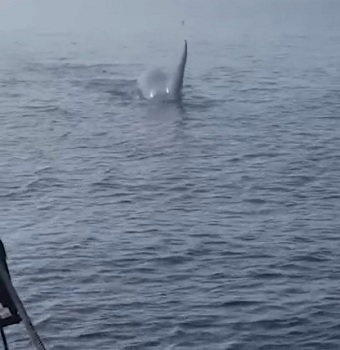
Rare Sighting: Killer Whale Cruising Cape Cod Waters is 30′ Bull Named ‘Old Thom’
The killer whale recently spotted swimming in the waters off Cape Cod is a huge 30-foot bull known as Old Thom. Just under two weeks ago the killer whale was spotted swimming 40 miles east of Nantucket, Massachusetts. Fisherman Jerry Leeman managed to capture a video of the rare sighting. In the footage, an orca can be seen swimming alongside his fishing boat. Killer whales are commonly seen off the West Coast of the U.S, however, it is incredibly rare to see them in New England—these waters are usually great white shark territory. >click to read< 10:57






